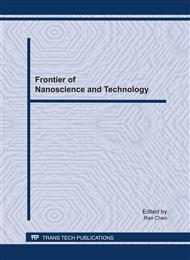p.625
p.630
p.635
p.640
p.645
p.650
p.657
p.662
p.667
White Organic Light-Emitting Diode Based on Organic Quantum Well Structure
Abstract:
A white organic light-emitting diode (WOLED) with an organic quantum well structure of ITO/N,N’-diphenyl-N,N’-bis(3-methylphenyl)-1,1’-biphenyl-4,4’-diamine (TPD) / 4,7-Diphenyl-1,10-phenanthroline (Bphen)/5,6,11,12-tetraphenylnapthacene (Rubrene)/Bphen /LiF/Al was fabricated by vacuum evaporation. The electroluminescence (EL) spectrum of the as-fabricated WOLED covers from 380nm to 700nm of the visible light region with a blue emission from TPD and an interesting wide emission peaked at 525nm, which can be decomposed into three emissions at 480nm, 525nm, and 555nm, respectively. The peaks at 525nm and 555nm are attributed to the excitation emission from the Bphen/Rubrene/Bphen quantum well structure, which are obviously blue-shifted in comparison with the photoluminescence (PL) spectrum of Rubrene. The new peak at 480nm is attributed to the exciplex emission at TPD/Bphen interface since it was also observed in the PL spectra. The white light of the WOLED comes from combined contribution of exciplex emission and organic quantum well structure.
Info:
Periodical:
Pages:
645-649
Citation:
Online since:
July 2011
Authors:
Keywords:
Price:
Сopyright:
© 2011 Trans Tech Publications Ltd. All Rights Reserved
Share:
Citation:


